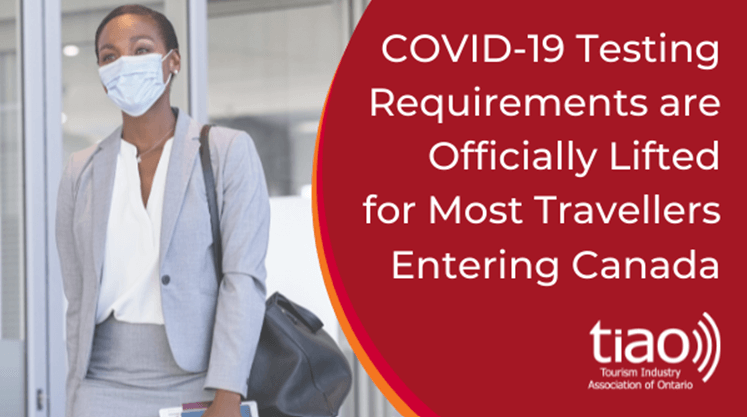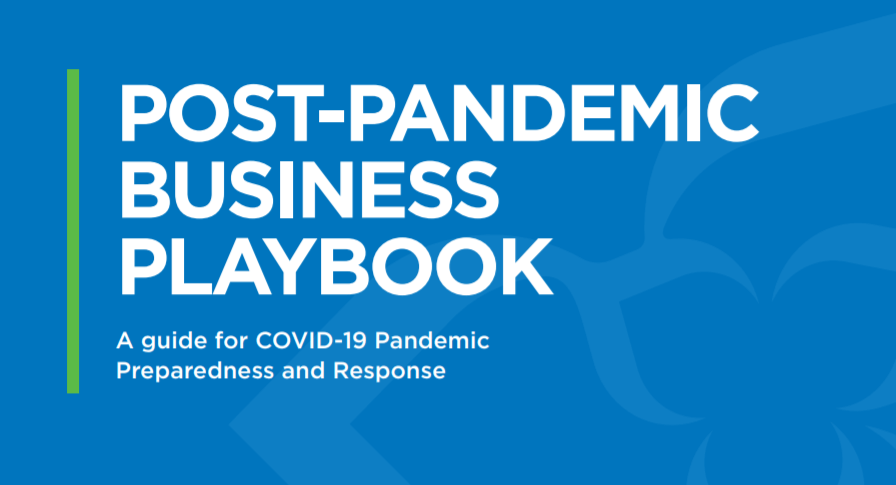COVID-19
RTO9 strives to support the tourism and travel industry in the region by closely monitoring events that could cause significant challenges to the industry, including the Covid-19 virus.

COVID-19 Testing Requirements are Officially Lifted for Most Travellers Entering Canada
As of April 1, 2022, fully vaccinated travellers entering Canada will no longer be required to take a pre-entry COVID-19 test. Travellers must still use the ArriveCAN app within 72 hours before arrival into Canada. Pre-entry testing is still required for unvaccinated and partially vaccinated children 5 years of age or older, even if they are accompanying a fully vaccinated adult. Children who are less than 5 years old are not required to test, regardless of their vaccination status. Randomized, mandatory COVID-19 testing is still in place, regardless of vaccination status, however, those who are randomly selected for testing will not have to isolate while they wait for their results.

Rediscover Ontario and Get Back up to 20 percent on Eligible Accommodation Expenses
The Ontario government is encouraging the people of Ontario to rediscover the province and support Ontario’s important tourism industry this March Break and all year round with the Ontario Staycation Tax Credit. With this Personal Income Tax credit, residents will get back up to 20 percent on their eligible accommodation expenses for leisure stays in the province this year.

Ontario Lifting Most Remaining COVID-19 Public Health Measures, Including Mask Mandates
After almost two years of COVID-19 restrictions and public health mandates, the provincial government has announced a timeline for removing all public health restrictions, including mask mandates.

Ontario Has Lifted Capacity Limits and Proof of Vaccination Requirements
As public health and health system indicators have continued to improve, Ontario has lifted capacity limits in all remaining indoor public settings and has lifted proof of vaccination requirements for all settings at this time. Businesses and other settings may choose to continue to require proof of vaccination. Masking requirements will remain in place at this time.

Ontario Moving to Next Phase of Reopening on February 17
With key public health and health system indicators continuing to improve, the Ontario government, in consultation with the Chief Medical Officer of Health, is cautiously and gradually easing public health measures sooner, with the next phase of measures being eased on February 17, 2022 at 12:01 a.m.

New Supports for Small Businesses, Workers and Families - January 10th
Minister MacLeod and Ontario Finance Minister Peter Bethlenfalvy hosted a technical briefing to discuss new targeted relief measures for businesses and people impacted by the current public health measures aimed at reducing the spread of the Omicron variant.

COVID-19 Public Health Measures and Advice
Find out about the latest public health measures, advice and restrictions.

Ontario moves schools to online learning, bans indoor dining and issues new COVID capacity restrictions
Ontario implements more capacity limits, closures for businesses. Ford issued several new measures and capacity limits for Ontario businesses, beginning Wednesday, Jan. 5 at 12:01 a.m. These measures will be in place for at least 21 days (until Jan. 26).

Ontario Reintroducing Capacity Limits in Indoor Venues that hold 1000+ People
The Ontario government has announced that as of December 18 at 12:01am, indoor facilities that can host more than 1,000 people are being reduced to a capacity limit of 50%.

Canadian Travel Requirements
The federal government announced that they will be reimposing the COVID-19 testing requirement for all travellers entering Canada (exception for those travelling from the US). Anyone landing in Canada will need to be tested at the airport they arrive at and will need to isolate until they receive their test results.

Impact Assessment of COVID-19 on Ontario’s Indigenous Tourism Industry
The comprehensive Impact Assessment of COVID-19 on Ontario’s Indigenous Tourism Industry, commissioned by ITO, projects Indigenous tourism in the province will only partially recover in 2022 and will not return to 2019 GDP and employment levels until 2023.

Addressing the COVID-19 Omicron Variant
On November 26, 2021, WHO has classified Omicron as a variant of concern. After identifying several cases across Canada, the federal government has announced additional border measures to reduce the risk of importing and transmission of COVID-19 and its variants in Canada related to international travel.

Ontario Pausing the Lifting of Capacity Limits in Remaining Settings Where Proof of Vaccination is Required
The Ontario government, in consultation with the Chief Medical Officer of Health, is pausing the lifting of capacity limits in remaining higher-risk settings as outlined in A Plan to Safely Reopen Ontario and Manage COVID-19 for the Long-Term. This is being done out of an abundance of caution as the province monitors public health trends.

Overview of Ontario’s 2021 Economic Outlook and Fiscal Review
Peter Bethlenfalvy, Minister of Finance, delivered the 2021 Ontario Economic Outlook and Fiscal Review. Ontario is making numerous investments over the next several years in Ontario’s economic recovery and growth, including a Travel Staycation Tax Credit, job creation throughout the province, and in the health sector.

Apple Wallet Update Now Compatible with Ontario Vaccine Certificate
Individuals who use an Apple mobile device can now choose to add their enhanced vaccine certificate with official QR code directly to their Apple Wallet. This feature is available with iOS 15.1, Apple’s newest operating system for iPhones that launched this week, and provides users with a convenient way to access and display their proof of vaccination from their device.

Ontario Releases Plan to Safely Reopen Ontario and Manage COVID-19 for the Long-Term
The Ontario government, in consultation with the Chief Medical Officer of Health, has released A Plan to Safely Reopen Ontario and Manage COVID-19 for the Long-Term, which outlines the province’s gradual approach to lifting remaining public health and workplace safety measures by March 2022. The plan will be guided by the ongoing assessment of key public health and health care indicators and supported by local or regional tailored responses to COVID-19.

Freeland says new ‘targeted’ COVID-19 benefit programs to cost$7.4-billion, run until May 7
Speaking at a news conference with Prime Minister Justin Trudeau, Ms. Freeland announced what she said will hopefully be the “final pivot” in terms of direct income support programs. Thursday’s announcement includes two new programs: one is a wage and rent support program aimed at the tourism sector called the Tourism and Hospitality Recovery Program. The minister said this would apply to hotels, restaurants and travel agencies that are still facing public health restrictions.

Ontario to Remove Work Certification Barrier for Immigrants
Ontario immigrants who qualify for certain trades and occupations will no longer be required to have job experience in the province to obtain work certification, under legislation to be introduced by Labor Minister Monte McNaughton.

Proof of Vaccination Guidance for Businesses and Organizations
This guidance document sets out baseline requirements that specified businesses and organizations must comply with.

Reopening Ontario
Learn about the Roadmap to Reopen, the province’s three-step plan to safely and gradually lift public health measures based on ongoing progress of provincewide vaccination rates and improvements of key public health and health care indicators.

Impact of COVID-19 on the Canadian Economy and Consumer Sentiment - as of August 24, 2021
To better understand the impact of COVID-19 on the economy, the consumer mindset and to inform marketing recovery strategies, Destination Ontario has accessed various economic, public attitude and behavior studies.

The Long-Term Impacts of COVID-19 on Ontario’s Tourism Businesses and Capacities to Reopen, Rebuild, and Recover
The impacts of the COVID-19 pandemic on Ontario’s tourism businesses have been wide-ranging and significant. After fifteen months of closures, job losses, layoffs, revenue losses, and mounting debt, the tourism industry faces a long process of recovering and rebuilding. As Ontario moves to Steps 2 and 3 this summer under the province’s Roadmap to Reopen framework, many tourism businesses are encountering challenges to reopening, rebuilding, and long-term recovery just as provincial and federal supports begin to wind down.

Revisiting Tourism: Canada’s Visitor Economy One Year into the Global Pandemic
Recovery is forecasted to take years, but a significant increase in domestic travel can accelerate recovery by one year. Because of its service nature, tourism is the most impacted sector in the Canadian economy. Canada’s major cities have been hit the hardest by the loss of tourism revenue.

Destination Ontario - Impact of COVID-19 on the Canadian Economy and Consumer Sentiment
To better understand the impact of COVID-19 on the economy, the consumer mindset and to inform marketing recovery strategies, Destination Ontario has accessed various economic and public attitude and behavior studies.

State of Tourism In Canada During COVID-19
TOP TRENDS FOR 2021
2021 will be a year of slow transition. Barring any unexpected catastrophes and a continuation of vaccinations, individuals, the travel and tourism industry and society can slowly begin looking forward to shaping futures through a lens of innovation and opportunity. This report focuses on the top 21 trends, insights and predictions from leading travel and tourism sources to support industry stakeholders frame the future of travel and tourism in 2021

Destination Ontario - Impact of COVID-19 on the Canadian Economy and Consumer Sentiment
Destination Ontario has put together information on forecasted economic outcomes, a micro-economic outlook, a travel outlook, and media consumption information.
To better understand the impact of COVID-19 on the economy, the consumer mindset and to inform
marketing recovery strategies, Destination Ontario has accessed various economic and public attitude and behavior studies.
This information should be treated as a snapshot in time.

ArriveCAN Awareness Toolkit
As part of Canada’s efforts to reduce the spread of COVID-19, all travellers are required to provide specific information upon and after entry into Canada. This includes requirements to provide a quarantine plan and contact and travel information. The Government of Canada introduced ArriveCAN in April 2020 to create a secure and user-friendly way to help travellers comply with these border measures. ArriveCAN is available as a mobile app or by signing in online.

Destination Ontario - Impact of COVID-19 on the Canadian Economy and Consumer Sentiment
Destination Ontario has put together information on forecasted economic outcomes, a micro-economic outlook, a travel outlook, and media consumption information.
To better understand the impact of COVID-19 on the economy, the consumer mindset and to inform marketing recovery strategies, Destination Ontario has accessed various economic and public attitude and behavior studies.
This information should be treated as a snapshot in time.

TIAO Survey #7 Results
Ontario Regional Tourism Organization 9
Covid-19 Survey 7 Results
July 17-31, 2020

A Framework for Reopening our Province: Stage 3
The government is continuing its gradual, staged approach to reopening Ontario, restarting the economy and easing the necessary restrictions that were put in place to contain the spread of the COVID‑19 outbreak, as outlined in A Framework for Reopening our Province.

RTO9 Immediate Action Plan & Interim Strategy
RTO9’s strong reliance on local and regional source markets will be an opportunity as those destinations will be among the first to recover as the lifting or continuation of travel restrictions across Canada and the globe will be different. The gradual recovery of the tourism market will require a strategic focus, here's a look at our strategy.

TIAO Survey #6 Results
Ontario Regional Tourism Organization 9
Covid-19 Survey 6 Results
June 10 - 19, 2020

Post-Pandemic Business Playbook
The Workplace Safety & Prevention Services has created a Post-Pandemic Business Playbook and a series of additional resources to help businesses on the road to recovery. Download the playbook by clicking the link below.

Checklist for Food Premises Operating Patios
The Leeds, Grenville & Lanark District Health Unit would like to provide guidance to support owners/operators in their plans to open patios included in stage 2 of the Reopening Ontario Plan. While we have worked hard to flatten the curve, and our risk is lower, COVID-19 remains a public health threat and therefore public health measures must remain in place as we open up local businesses and services.

Phase 2: Restart
This stage introduces a new, regional approach to reopening, based on trends of key public health indicators outlined in the framework, including virus spread and containment, as well as health system and incidence-tracking capacity. The approach will reflect the evolving public health situation provincially and in each region. In close cooperation with our partners, Ontario’s approach will continue to be informed by the best available medical and scientific advice.

Regional Relief and Recovery Fund (RRRF)
The Regional Relief and Recovery Fund (RRRF) provides financial contributions (interest-free loans) to help support fixed operating costs of SMEs, where business revenues have been affected by the COVID-19 pandemic.

Destination Ontario - Impact of COVID-19 on the Canadian Economy and Consumer Sentiment
Destination Ontario has put together information on forecasted economic outcomes, a micro-economic outlook, a travel outlook and media consumption information.

TIAO Survey #5 Results
Ontario Regional Tourism Organization 9
Covid-19 Survey 5 Results
May 13 – 19, 2020

Stage 1 of Framework to Reopen Ontario
The Ontario Government announced details of stage one of "A Framework to Reopen Our Province", which will begin on May 19th, provided that public health metrics continue to trend in a positive direction.

Health and Safety for Tourism and Hospitality Sector
Workplace Safety & Prevention Services
Guidance on Health and Safety for Tourism and Hospitality Sector during COVID-19

TIAO Survey #4 Results
Ontario Regional Tourism Organizations
Covid-19 Survey 4 Results
April 22 –27, 2020

TIAO Survey #3 Results
Thank you for the help to build the most comprehensive picture of the very latest developments on the front-line. It's vital that we are able to monitor and feedback this information to the government.

TIAO Survey Results
TIAO set out to design a survey to measure the impact of COVID-19 on tourism businesses and workers across Ontario.

COVID-19 Resources, Updates and News
As the voice of the Ontario tourism industry, we recognize that in times of uncertainty there is a need for the industry to have access to clear and reliable information.

Canada Emergency Response Benefit
If you have stopped working because of COVID-19, the Canada Emergency Response Benefit (CERB) may provide you with temporary income support. The CERB provides $500 a week for up to 16 weeks.

Prime Minister announces additional support for small businesses
Small businesses are the backbone of our economy and are vital for our families and communities across the country. They are facing economic hardship and uncertainty during the COVID-19 pandemic.

TIAC - COVID-19 Impact on Tourism
During this time, it is integral that the tourism industry comes together to support one another. TIAC is committed to representing Canadian tourism businesses in the face of uncertainty and continues to advocate on behalf of the industry.

Tele-Townhall Recordings - Minister MacLeod
Please find below links to both the first and second tele-townhall recordings that Minister MacLeod held with industry-wide stakeholders on March 19, 2020, and March 26, 2020, respectively.

WSIB Financial Relief Package
At the WSIB, we understand the impact the evolving COVID-19 situation is having on businesses across Ontario. We have announced a financial relief package worth up to $1.9 billion to help support you through this difficult time while protecting coverage for people with work related injuries or illness.

Government of Canada's COVID-19 website
The national coronavirus information line (1-833-784-4397) is available from 7:00 a.m. to midnight (EST) seven days a week.

UPDATES ON THE COVID-19 SITUATION -Destination Canada
Ongoing support for the Visitor Economy
We know these are difficult times within the tourism sector. We know there is a lot of uncertainty around what our world will look like next month, next week, and even tomorrow.

Novel Coronavirus (COVID-19)
Learn about how the Ministry of Health is preparing for the 2019 novel coronavirus in Ontario. Find out how to protect yourself, what to do if you’re sick after you travel and how to recognize possible symptoms.

EPI-Win – World Health Organization Network for Information in Epidemics
In the absence of such information rumours can spread rapidly through social media, resulting in an INFODEMIC. EPI-WIN is the WHO Information Network for Epidemics that will provide tailored information to different audiences during a public health event.

United Nations World Tourism Organization
In an update on the sector’s response to the coronavirus COVID-19 outbreak, the World Tourism Organization (UNWTO) offers a first assessment pointing to a decrease in international arrivals and receipts in 2020.

Public Health Agency of Canada
This illness summary is updated once every weekday with the information provided by provinces and territories. A detailed epidemiologic summary is also available.

World Travel and Tourism Council – Advice on Coronavirus Outbreak
The latest advice on how to travel responsibly during the Coronavirus Outbreak.

Twenty31 Consulting - COVID-19: A Strategic Approach to Address Global and Regional Tourism Management Challenges
The Covid-19 virus has evolved from its first detection in December 2019, to one of the most acute, recent threats to the global travel and tourism industry.
This unprecedented challenge has been fueled by a lack of understanding of how the disease is transmitted and the relatively long and symptom-free incubation period with the great majority unknowingly passing along the disease.

